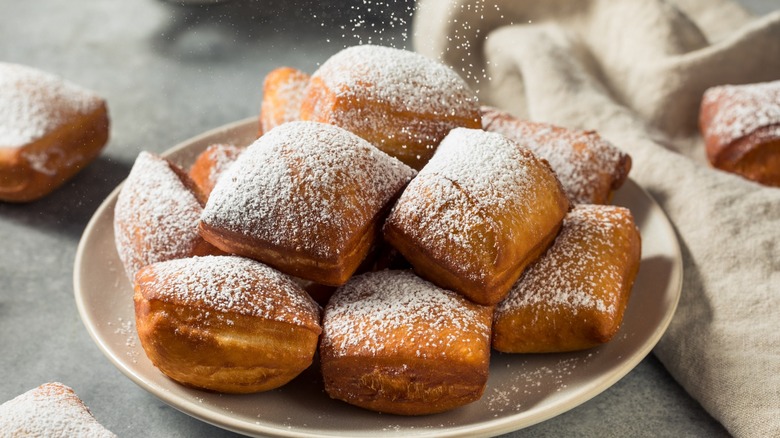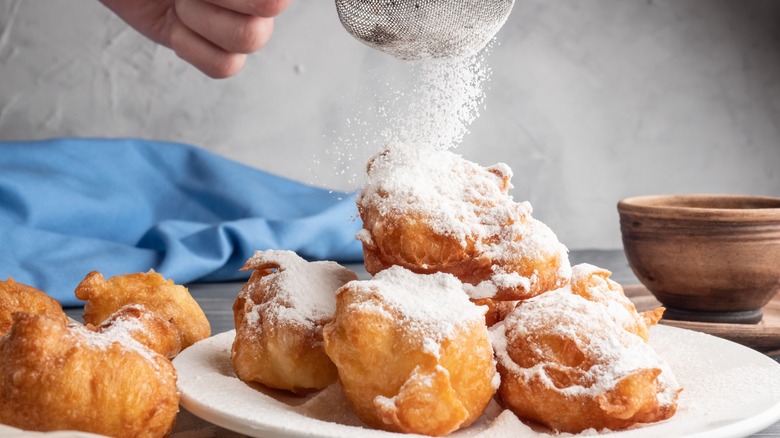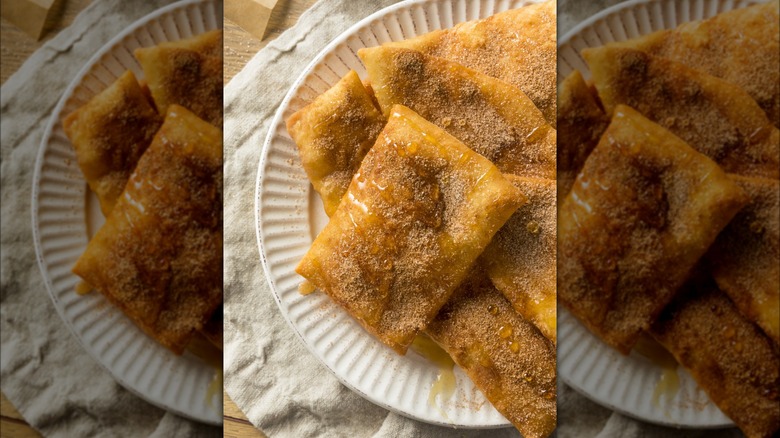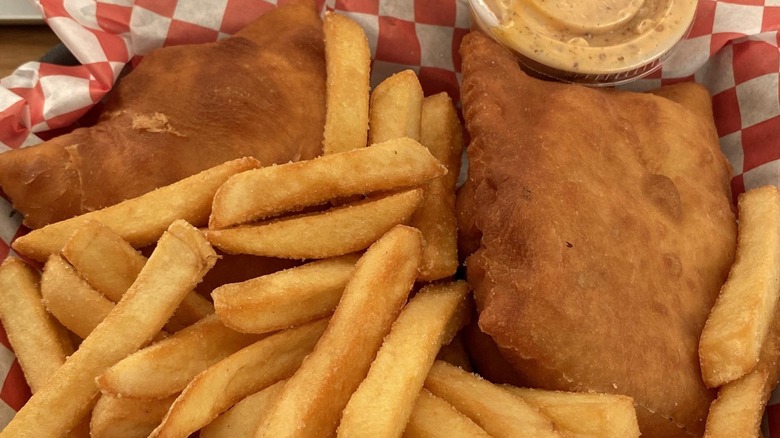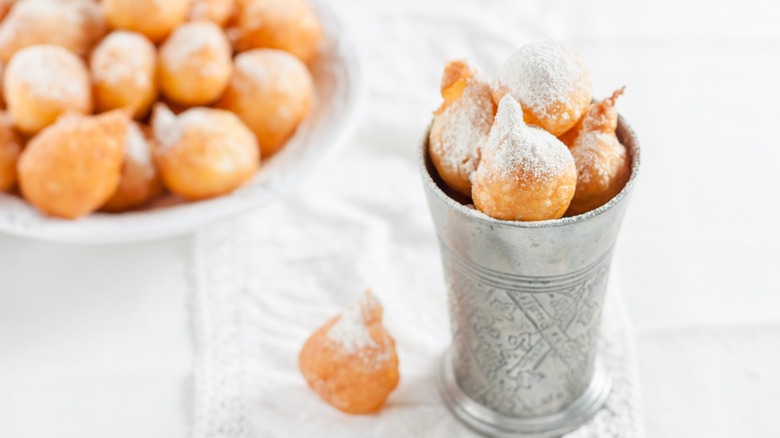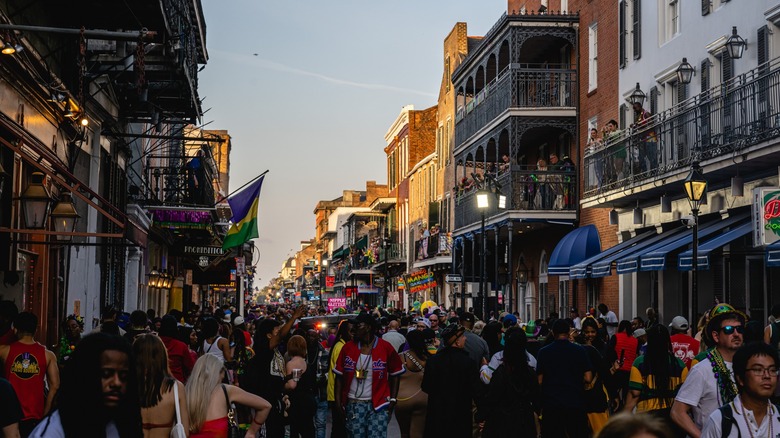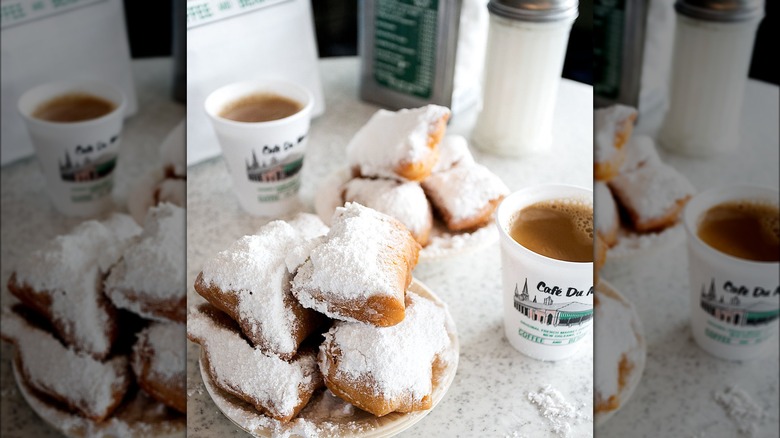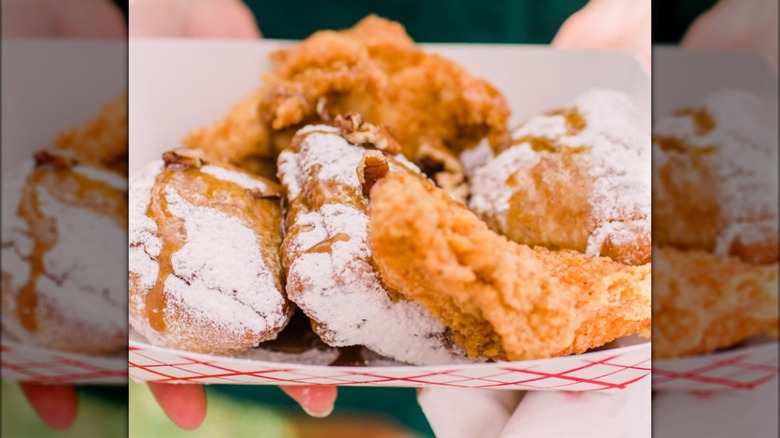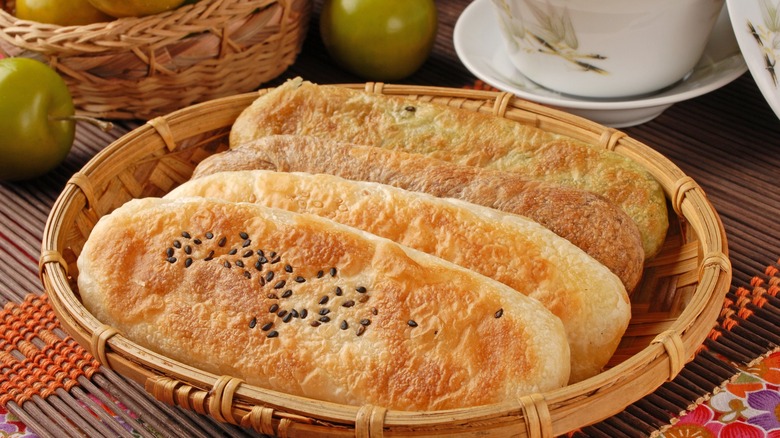Everything You Need To Know About Beignets
If you've ever seen the word "beignet" and wondered exactly how to say it without getting it wrong, let us help you out. It's pronounced "ben-yay," which is pretty accurate as that's exactly how eating one of these pillowy little treats makes you feel!
But what is a beignet, where can you find them, and what's the history behind them? Turns out, there are a whole host of interesting and quirky facts about beignets that you probably didn't know about. Don't worry — we've got everything you need to know about beignets right here.
Before we get started, let's look at what exactly beignets are. In simple terms, they're a French doughnut, shaped into a square, with a hole in the middle. A good beignet is light and airy even though it's been deep-fried. Made from choux pastry, the sweetened, yeasted dough is liberally covered in powdered sugar after frying. Beignets don't have to be sweet, though — they can be savory, too! More on that later.
It isn't yeast that makes beignets so light and pillowy
Yeast is usually added to dough to help it rise — it's what makes bread fluffy and buns pillowy. So it makes sense that beignets, the fluffy French doughnuts we know and love, have yeast in their dough recipe, right? You might be surprised to know that it isn't the yeast in beignets that makes them so light and airy, though.
Beignets are made from choux pastry, and this type of pastry is renowned for its high moisture content. When it cooks, this moisture content creates steam, helping the dough rise and ensuring the finished beignets are soft, pillowy, and fluffy. You can see similar results with other types of choux pastry, such as profiteroles, though these don't contain any yeast.
Not all beignet recipes use yeast, though. Some use baking powder as a leavening agent. Beignets made without yeast are typically airier and fluffier than the yeasted ones sold in New Orleans, which have a denser, chewier texture.
Beignet means fritter in French
You'd be forgiven for thinking that beignets have their roots in France — after all, they're also known as French doughnuts and the word itself means "fritter" in French. But beignets are actually thought to date back to ancient Rome. The word "beignet" comes from the Celtic word "bigne" meaning "to raise." In ancient Rome, a similar dessert was prepared called "scriblita, " consisting of a moisture-rich dough boiled in animal fat. Mmm!
The original recipe for beignets did eventually make its way to France, but it may have come via Spain or Mexico. There, they make a fluffy fried pastry known as sopapillas. These resemble beignets but are usually circular or triangular in shape, and often doused with syrup and cinnamon.
Although the home of the beignet is New Orleans, you'll find them all over the U.S. If you're traveling abroad, almost every country has its own iteration of beignets or fried doughnuts.
Beignets can be sweet or savory
If you've never had a sweet beignet before, where have you been? By far the most common — and most traditional — beignets are the sweet ones doused in powdered sugar, which you'll find practically everywhere in New Orleans, although everyone has their own favorite spot.
You might not know that beignets don't have to be sweet, though. They can be savory, too! In New Orleans, you'll find everything from beer-battered crab beignets to Philly cheesesteak beignets. Head for brunch at Copper Vine for their legendary Louisiana crawfish beignets with Meyer lemon aioli, or grab a table at Stuph'D Beignets & Burgers and dive into their stuffed savory beignets, which come with a variety of different fillings.
Of course, if you fancy keeping it old-school with sweet beignets, you're spoiled for choice in NOLA. Some establishments serve their beignets with dipping sauces, while others dish up stuffed versions, like the praline-filled beignets at Loretta's Authentic Pralines.
Nuns may have brought beignets to New Orleans
If beignets originated in Rome and made their way to France, how did they end up in New Orleans? We may never actually know if it's true or not, but legend has it that the secret recipe for Cafe du Monde's beignets was brought to NOLA from France by the Ursuline nuns. Eleven of them settled in the city in 1727, opening a convent and a school for girls, which taught a diverse group of young people from the community.
What's more likely is that French Acadian colonists brought the beignet recipe with them from France to Canada. When displaced from their Nova Scotian homes by the British, they took the recipe to New Orleans in the 1700s. It wasn't until 1862 that Cafe du Monde opened and began selling their now-world-famous beignets.
Nuns seem to be inextricably connected to the history of the beignets, and similar sweet treats, though. More on that coming up!
The French call them Nun's Farts
In France, they enjoy a version of the beignet called "pets de nonne." Translated, this means "nun's farts." Though they're similar in flavor to beignets, they look quite different, and are usually round in shape, more like a profiterole in appearance. They're also much smaller than classic beignets, being around 1.5 inches in diameter and hollow inside, whereas beignets are typically around two inches square.
Don't confuse them with the French-Canadian treat pets de soeurs (sister's farts) which are made from pie dough and usually spiral-shaped. Prior to pets de nonne, there was also a French pastry called pets d'Espange, or Spanish farts, that was popular in the 14th century.
Beignets are not only larger than nun's farts, they are also usually square or rectangular-shaped pillows. Pets de nonne, as we just mentioned, are usually round and are rolled in sugar before serving. In contrast, beignets are liberally dusted with powdered sugar, which can make them quite messy to eat, but truly delightful.
Beignets were made for Mardi Gras to use up ingredients before Lent
If you've ever been to New Orleans during Mardi Gras, French for Fat Tuesday, you'll know how the city comes alive with parades, colorful costumes, live music, and street food. Beginning on Twelfth Night, carnival season in NOLA is the event of the year, and Mardi Gras falls on Shrove Tuesday, on a different date each year in February or March.
Traditionally, Shrove Tuesday was the day before 40 days of fasting for Lent began. This was a day where people would bake to use up all the fatty ingredients that couldn't be preserved during the fast, like eggs, sugar, and butter. They made little fried pieces of dough sprinkled in sugar — or beignets — as well as pancakes and pastries.
Beignets aren't the only sweet doughnuts associated with Mardi Gras. Fried sweet rice dumplings known as Calas arrived in NOLA in the late 18th century, when Catholic African-American families served them at celebrations including Fat Tuesday.
The best beignets in NOLA
Ask any New Orleanian where the best beignet spot in town is and their answer will, inevitably, vary. Everyone has their own favorite place to grab beignets, but there's nowhere as famous as Cafe du Monde. Opened in 1862, this world-renowned cafe serves just one thing: Beignets. Of course, they also have a selection of drinks to accompany your beignets, including chicory coffee and delicious hot chocolate, but there are no other sweet treats on the menu.
Cafe du Monde didn't always call its fried pillowy treats beignets. The cafe originally named them French doughnuts, and it wasn't until 1958 that they were rebranded as beignets. You can sit in for an indulgent treat, get your beignets to go, or even pick up boxes of beignet mix so you can whip up your own at home.
There are some who insist that the best beignet spot in town is Morning Call, others who claim the beignet bites at The Vintage are the bomb, and those who swear by the praline-filled beignets at Loretta's in the French Market. The only way to find out where has the best beignets for your tastes is to try them all!
Beignets and cafe au lait are a classic pairing
What's the best way to enjoy beignets? In case you've never tried them or if you're unsure what to pair them with, it pays to keep it classic. The combo of soft, pillowy, sugar-dusted sweet beignets and milky cafe au lait is sublime. That milky coffee just complements the sweet fried choux pastry like nothing else. Although cafe au lait is the traditional pairing, any type of coffee is a must, as the bitterness of the coffee makes the sweetness of the beignets pop even more.
Don't like coffee? There are some other things that go well with beignets, too. Tea aficionados can try a subtly spiced Chai or a lightly sweetened Earl Grey. If you're looking for true indulgence, add some ice cream or dipping sauce on the side of your sweet beignets. And if you want to pair your beignets with alcohol, dessert wines or prosecco are a good starting point. For something harder, bourbon or cognac ticks the right boxes. Even dark craft beer like stouts or porters are a delicious match for sugary beignets.
Beignets are Louisiana's official state doughnut
Beignets aren't just a much-loved sweet treat in NOLA, they're also a significant part of Louisiana's history and culture. So much so, in fact, that in 1986 they became designated as the state's official doughnut. As well as being an integral part of Mardi Gras celebrations, beignets are so beloved that they sparked their own festival.
Beignet Fest takes place in New Orleans every Fall, usually around September. Launched in 2016, it's the brainchild of Amy and Sherwood Collins, who started the festival to help their autistic son and other children with Autistic Spectrum Disorder (ASD) find support in the NOLA area, something that was lacking at the time of their child's diagnosis. The festival uses proceeds to make grants for support for families struggling to find local ASD programs.
As well as all proceeds going to worthy causes, Beignet Fest is a lot of fun, with sweet and savory beignet dishes from some of NOLA's best restaurants and food trucks, live music from local artists, a beer garden, and more. The Vintage, Loretta's Authentic Pralines, and Cafe Beignet were there in 2023, serving up their authentic beignets, while other treats included cheesecake-stuffed snoballs from Sno-La Snowballs and fried chicken from Chubbie's.
Most countries have their own take on the Beignet
Don't be fooled into thinking you can only get beignets in New Orleans. These awesome little doughnuts can be found in almost every major city in the U.S., and nearly every country in the world has its own take on beignets, too. Though, for the ultimate authentic experience, you'll still want to hit NOLA.
In Mexico, there's the churro, deep-fried sweet fritters rolled in cinnamon sugar, usually served with melted chocolate for dipping. Spain's sopapillas, sometimes known as Navajo tacos, are round or triangle-shaped fritters often doused with syrup and sprinkled with cinnamon — they share their light, airy, pillowy texture with traditional beignets.
In Hong Kong, ox-tongue pastries, also known as horseshoe fritters (ma kiok) are lightly sweetened, puffy fried doughnuts filled with a paste made with white sesame seeds. They're served as a popular snack or for breakfast.
Earlier we mentioned pets de nonne and pets de soeur, the fried French pastries named after nuns and sisters. Then there's the an-doughnut, a popular Japanese doughnut that's usually filled with azuki red bean paste or white bean paste and coated with granulated or powdered sugar.
